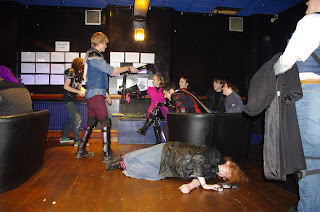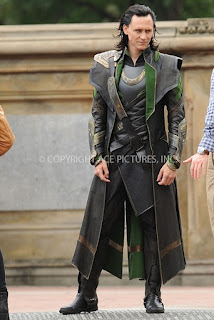The environment is a game is a huge part of what immerses
the player in an experience. Of course, believable scripts and good acting as
well as natural movements and believable reactions play a part in helping the
gamer forget they’re playing, but if the area or world they’re in isn’t up to
scratch, then no amount of authentic screaming is going to help. It’s just
going to sound silly.
 |
| If it wasn't for the repetative dialogue, you could forget where you were (http://www.gameranx.com/updates/id/3036/article/new-skyrim-info-blowout/) |
I’ve personally seen this not only in video games, but in
the LARPs I’ve attended; Leicester after Dark is held in secret locations, you’re
a vampire meeting other vampires out of the way of human eyes and when you’re
doing the secret knock to get into the summer venue, you really feel like you
are your character. When you’re running through the woods with a sword in hand,
you don’t feel like you arrived on a minibus and you forget you’ve got a mobile
phone tucked in your belt for emergencies. You’re immersed in the game and your
character, and it’s the scenery and environment that get you there. There’s a
reason we spent three hours arranging candles in the rafters of the Tavern
building; When we sat and ate food off tin plates in the light of our lanterns,
you were in that fantasy tavern, not just pretending. And that’s ultimately
what game designers hope to achieve in their games – for at least a little while,
whilst you’re playing they’re attempting to suspend your disbelief and let you
live the story through the eyes of your character. You’ve got to see what they
see and fight what they fight but you’ve also got to feel what they feel. Set
dressing, atmosphere, backgrounds, lighting and music all come together to immerse
the gamer in the world they’re experiencing. It’s all about making the players
gasp when their character would gasp, startle, jump and panic when someone
experiencing that situation for real would do the same. It’s a tough balance to
hit, but when you do hit it, there’s a lot to be said about a game you can just
fall into.
 |
| Post apocalyptic nightclub in Futurisic Rome, wouldn't be the same if the game was held in someone's front room. Immersive environments apply to any game where you're taking on a role |
Now the primary function of the environment is to help the
player navigate the game. It can’t be too intrusive, but at the same time it’s
frustrating if the player is running in circles with no direction. Having
interactive items is one way of showing the player this is where they’re meant
to be, or a ‘beacon’ style object for the players to head towards. At it’s most
extreme a player may be herded towards the goal – put a man at the end of a
canyon, where else can he go but the other end? But for some players this can
feel annoying and condescending, especially if it’s done by putting invisible
barriers over possible side routes. Some games also have in-game threats that
prevent wandering; in Okami any attempt to leave the shore by swimming out to
sea will either result in drowning (the character can only swim so far) or
being eaten by a giant sea dragon.
 |
| This area is out of bounds. (http://13xforever.gamerdna.com/images/EW81oblE/sea-dragon) |
The game environment is tasked with creating emotions and
reactions felt in the real world. However the range of senses available to it
is limited; when all are utilized in the real world to trigger emotion and
response, in a video game the only available ones are sight and sound. To a
limited extent touch is being used now, controllers that buzz and vibrate, or
ones that require the players to move in a certain way are used but there’s no
facility available to make an in-game rock feel like a rock, and you certainly
can’t smell the grass of Hyrule field as you ride across it. Through careful lighting,
colouring and positioning of elements the game can create feelings and
impressions however which almost leave you feeling like you’ve touched and
smelt the fictional world; Buildings close, with dark colours and evening
lighting or even night time settings can produce feelings of foreboding whilst
open vistas, the clean light of a spring day and the sounds of the wild elicit
hope and wonder. In an out of cinematic cut scenes these effects are used to
tell the player how to feel.
And these techniques can be used to train the gamer as well;
over the course of the game (Much the same as films etc.) the player can be
conditioned to see certain colour schemes and tones as ‘safe’ or ‘unsafe’.
These techniques aren’t exclusively used in the visual side of the environment;
gamers will often comment on how they know an enemy is coming on how the music
shifts. This can be a simple increase of tempo leading to subtle dread, or a
full-on startling change of song the ‘fight music’ in games like Pokémon, for
example.
The video game environment is forever striving for a sense
of believability and it’s divided opinion whether using stylization in this endeavour
is good or bad. Game graphics have become more advanced over the years, but
trying to be as realistic as possible really puts them in danger of falling
into the abyss of the uncanny valley; those characters are trying so hard to be human, but they’re just not quite there.
So what are they? It makes us shiver. It’s a primal instinct that warns us
there’s a wolf in sheep’s clothing and if you’re talking to your game character’s
wife who’s going to die in chapter five, it’s not the emotional response you
want.
 |
| The uncanny valley |
This is the same for environments; if the player senses it’s
weird or trying too hard to be normal, they’re going to be looking out for
something bad to happen, and that’s only good if that’s what’s going to happen.
Stylization removes this problem; if the player becomes used to a quirky game
world, then that becomes their new normal and they won’t be phased by it. They’ll
also notice peculiarities and hints to the plot when you put them in. It
removes the uncanny valley experience by not trying too hard, and it also
creates a distinctive look for your game that can be remembered easily.
 |
| You've got one guess to guess the game (http://www.computerandvideogames.com/195145/previews/animal-crossing-city-folk/) |
One of the environments that’s stuck with me the most is the
environments from Portal 2; Designed by Valve, it draws from scientific labs as
well as office buildings from various eras – from the fifties and sixties and
modern day leaning towards futuristic it draws office furniture and construction
as well as fonts, styles of art for posters and signs. With minimalistic music,
and colour schemes to scenes that instantly allow you to recognise which part
of the facility you’re in; blue and white are controlled by GLaDOS, the dank
grey areas are service tunnels and the more orange and brown present, the
further you are into Apertures past, the abandoned sub-sections of the facility
where the ghosts of the company live on through their pre-recorded tannoy
messages.
 |
| I know exactly where I am. And I am not thrilled to be here (http://forums.thinkingwithportals.com/community-releases/cassata-chamber-1-v1-0-t2436.html) |



